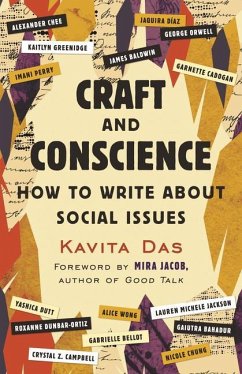25,99 €
inkl. MwSt.
Versandfertig in 2-4 Wochen

13 °P sammeln
- Broschiertes Buch
- Merkliste
- Auf die Merkliste
- Bewerten Bewerten
- Teilen
- Produkt teilen
- Produkterinnerung
- Produkterinnerung
"Craft and Conscience helps writers weave together their narrative craft, conscience, and analytical and research skills, to create prose to illuminate and underscore the individual and collective impact of crucial issues of our time"--
Andere Kunden interessierten sich auch für
![The Secrets of Story The Secrets of Story]() Matt BirdThe Secrets of Story24,99 €
Matt BirdThe Secrets of Story24,99 €![The Art of Creative Writing The Art of Creative Writing]() Lajos EgriThe Art of Creative Writing23,99 €
Lajos EgriThe Art of Creative Writing23,99 €![101 Things to Learn in Art School 101 Things to Learn in Art School]() Kit White101 Things to Learn in Art School11,99 €
Kit White101 Things to Learn in Art School11,99 €![Writing the Natural Way Writing the Natural Way]() Gabriele Lusser RicoWriting the Natural Way15,99 €
Gabriele Lusser RicoWriting the Natural Way15,99 €![The Elements of Style - Illustrated The Elements of Style - Illustrated]() Strunk, William, Jr.The Elements of Style - Illustrated11,99 €
Strunk, William, Jr.The Elements of Style - Illustrated11,99 €![The Reader Over Your Shoulder: A Handbook for Writers of English Prose The Reader Over Your Shoulder: A Handbook for Writers of English Prose]() Robert GravesThe Reader Over Your Shoulder: A Handbook for Writers of English Prose21,99 €
Robert GravesThe Reader Over Your Shoulder: A Handbook for Writers of English Prose21,99 €![Rethinking Curating Rethinking Curating]() Beryl GrahamRethinking Curating37,99 €
Beryl GrahamRethinking Curating37,99 €-
-
-
"Craft and Conscience helps writers weave together their narrative craft, conscience, and analytical and research skills, to create prose to illuminate and underscore the individual and collective impact of crucial issues of our time"--
Hinweis: Dieser Artikel kann nur an eine deutsche Lieferadresse ausgeliefert werden.
Hinweis: Dieser Artikel kann nur an eine deutsche Lieferadresse ausgeliefert werden.
Produktdetails
- Produktdetails
- Verlag: Beacon Press
- Seitenzahl: 344
- Erscheinungstermin: 4. Oktober 2022
- Englisch
- Abmessung: 226mm x 157mm x 28mm
- Gewicht: 394g
- ISBN-13: 9780807046494
- ISBN-10: 0807046493
- Artikelnr.: 63300599
- Herstellerkennzeichnung
- Libri GmbH
- Europaallee 1
- 36244 Bad Hersfeld
- gpsr@libri.de
- Verlag: Beacon Press
- Seitenzahl: 344
- Erscheinungstermin: 4. Oktober 2022
- Englisch
- Abmessung: 226mm x 157mm x 28mm
- Gewicht: 394g
- ISBN-13: 9780807046494
- ISBN-10: 0807046493
- Artikelnr.: 63300599
- Herstellerkennzeichnung
- Libri GmbH
- Europaallee 1
- 36244 Bad Hersfeld
- gpsr@libri.de
Kavita Das has taught nonfiction writing at the New School and Catapult and has written about social issues for ten years. Previously, she worked in the social change sector for fifteen years, addressing issues ranging from community and housing inequities to public health disparities and racial injustice. Das is also the author of the biography Poignant Song: The Life and Music of Lakshmi Shankar. Find her online at kavitadas.com and on Twitter (@kavitamix).
Foreword, by Mira Jacob
Introduction
CHAPTER 1
Why We Write: Interrogating Our Motivations for Writing About Social Issues
· “Why I Write,” by George Orwell
· “Autobiographical Notes,” from Notes of a Native Son, by James Baldwin
· “Ellaji and Lakshmiji,” by Kavita Das
CHAPTER 2
How We Are All Connected: Understanding the Relationship Between the
Writer, Reader, and Subject
· “Tramp,” by Kavita Das
· “Jyoti’s Rainbow,” by Kavita Das
· “Black and Blue,” by Garnette Cadogan
· “Football, Free on the Streets,” by Garnette Cadogan
CHAPTER 3
Diving In Deep or Casting Wide: Considering Context Versus Narrative to
Shape Our Stories
· “Red Ink of Revisionist History,” by Kavita Das
· “Selective Perception of Disinformation,” by Kavita Das
· “Introduction: This Land,” from An Indigenous Peoples’ History of the
United States, by Roxanne Dunbar-Ortiz
· From “Fear” in Breathe: A Letter to My Sons, by Imani Perry
· “How Could I Write About Women Whose Existence Is Barely Acknowledged?”
by Gaiutra Bahadur
CHAPTER 4
Writing from Outside In or Inside Out: Reporting, Personal Narrative, or a
Hybrid Approach
· “COVID-19 Vaccine: What White Conservatives Can Learn from Black
Americans,” by Kavita Das
· “A Virulent Privilege,” by Kavita Das
· “La Otra,” adapted from Ordinary Girls, by Jaquira Díaz
· “The School-to-Prison Pipeline Is Getting Worse for Black and Brown
Girls,” by Jaquira Díaz
· “99 Years After the Tulsa Race Massacre, an Artist Reflects,” by Crystal
Z Campbell
CHAPTER 5
Staking a Claim: Writing Opinion Pieces (Op-Eds)
· “The Anti-Vaxxer Threat amid a Pandemic,” by Kavita Das
· “Tolerance Has a Fatal Flaw. This Is the Solution,” by Kavita Das
· “Stories of Transracial Adoptees Must Be Heard—Even Uncomfortable Ones,”
by Nicole Chung
· “The Specter of Caste in Silicon Valley,” by Yashica Dutt
CHAPTER 6
Are You the Right Storyteller for This Story?: Understanding Cultural
Sensitivity and Avoiding Cultural Appropriation
· Introduction and Conclusion from White Negroes: When Cornrows Were in
Vogue . . . and Other Thoughts on Cultural Appropriation, by Lauren Michele
Jackson
· “Who Gets to Write What?” by Kaitlyn Greenidge
· “How to Unlearn Everything: When It Comes to Writing the ‘Other,&rsrquo;
What Questions Are We Not Asking?” by Alexander Chee
· “Who Gets to Write About Whom: Examining Authority, Authenticity, and
Appropriation in Biography,” by Kavita Das
CHAPTER 7
Ripple Effects of Making Waves: Implications (Good and Bad) of Writing
About Social Issues
· “Writers Shouldn’t Romanticize Rejection,” by Kavita Das
· “Recovering My Fifth Sense,” by Kavita Das
· “There Is No One Way,” by Alice Wong
· “Stepping on a Star,” from We Wear the Mask: 15 True Stories of Passing
in America, by Gabrielle Bellot
Conclusion
Acknowledgments
Recommended Resources
About Kavita Das, Author
About Mira Jacob, Foreword Writer
About the Contributors
Notes
Permissions
Introduction
CHAPTER 1
Why We Write: Interrogating Our Motivations for Writing About Social Issues
· “Why I Write,” by George Orwell
· “Autobiographical Notes,” from Notes of a Native Son, by James Baldwin
· “Ellaji and Lakshmiji,” by Kavita Das
CHAPTER 2
How We Are All Connected: Understanding the Relationship Between the
Writer, Reader, and Subject
· “Tramp,” by Kavita Das
· “Jyoti’s Rainbow,” by Kavita Das
· “Black and Blue,” by Garnette Cadogan
· “Football, Free on the Streets,” by Garnette Cadogan
CHAPTER 3
Diving In Deep or Casting Wide: Considering Context Versus Narrative to
Shape Our Stories
· “Red Ink of Revisionist History,” by Kavita Das
· “Selective Perception of Disinformation,” by Kavita Das
· “Introduction: This Land,” from An Indigenous Peoples’ History of the
United States, by Roxanne Dunbar-Ortiz
· From “Fear” in Breathe: A Letter to My Sons, by Imani Perry
· “How Could I Write About Women Whose Existence Is Barely Acknowledged?”
by Gaiutra Bahadur
CHAPTER 4
Writing from Outside In or Inside Out: Reporting, Personal Narrative, or a
Hybrid Approach
· “COVID-19 Vaccine: What White Conservatives Can Learn from Black
Americans,” by Kavita Das
· “A Virulent Privilege,” by Kavita Das
· “La Otra,” adapted from Ordinary Girls, by Jaquira Díaz
· “The School-to-Prison Pipeline Is Getting Worse for Black and Brown
Girls,” by Jaquira Díaz
· “99 Years After the Tulsa Race Massacre, an Artist Reflects,” by Crystal
Z Campbell
CHAPTER 5
Staking a Claim: Writing Opinion Pieces (Op-Eds)
· “The Anti-Vaxxer Threat amid a Pandemic,” by Kavita Das
· “Tolerance Has a Fatal Flaw. This Is the Solution,” by Kavita Das
· “Stories of Transracial Adoptees Must Be Heard—Even Uncomfortable Ones,”
by Nicole Chung
· “The Specter of Caste in Silicon Valley,” by Yashica Dutt
CHAPTER 6
Are You the Right Storyteller for This Story?: Understanding Cultural
Sensitivity and Avoiding Cultural Appropriation
· Introduction and Conclusion from White Negroes: When Cornrows Were in
Vogue . . . and Other Thoughts on Cultural Appropriation, by Lauren Michele
Jackson
· “Who Gets to Write What?” by Kaitlyn Greenidge
· “How to Unlearn Everything: When It Comes to Writing the ‘Other,&rsrquo;
What Questions Are We Not Asking?” by Alexander Chee
· “Who Gets to Write About Whom: Examining Authority, Authenticity, and
Appropriation in Biography,” by Kavita Das
CHAPTER 7
Ripple Effects of Making Waves: Implications (Good and Bad) of Writing
About Social Issues
· “Writers Shouldn’t Romanticize Rejection,” by Kavita Das
· “Recovering My Fifth Sense,” by Kavita Das
· “There Is No One Way,” by Alice Wong
· “Stepping on a Star,” from We Wear the Mask: 15 True Stories of Passing
in America, by Gabrielle Bellot
Conclusion
Acknowledgments
Recommended Resources
About Kavita Das, Author
About Mira Jacob, Foreword Writer
About the Contributors
Notes
Permissions
Foreword, by Mira Jacob
Introduction
CHAPTER 1
Why We Write: Interrogating Our Motivations for Writing About Social Issues
· “Why I Write,” by George Orwell
· “Autobiographical Notes,” from Notes of a Native Son, by James Baldwin
· “Ellaji and Lakshmiji,” by Kavita Das
CHAPTER 2
How We Are All Connected: Understanding the Relationship Between the
Writer, Reader, and Subject
· “Tramp,” by Kavita Das
· “Jyoti’s Rainbow,” by Kavita Das
· “Black and Blue,” by Garnette Cadogan
· “Football, Free on the Streets,” by Garnette Cadogan
CHAPTER 3
Diving In Deep or Casting Wide: Considering Context Versus Narrative to
Shape Our Stories
· “Red Ink of Revisionist History,” by Kavita Das
· “Selective Perception of Disinformation,” by Kavita Das
· “Introduction: This Land,” from An Indigenous Peoples’ History of the
United States, by Roxanne Dunbar-Ortiz
· From “Fear” in Breathe: A Letter to My Sons, by Imani Perry
· “How Could I Write About Women Whose Existence Is Barely Acknowledged?”
by Gaiutra Bahadur
CHAPTER 4
Writing from Outside In or Inside Out: Reporting, Personal Narrative, or a
Hybrid Approach
· “COVID-19 Vaccine: What White Conservatives Can Learn from Black
Americans,” by Kavita Das
· “A Virulent Privilege,” by Kavita Das
· “La Otra,” adapted from Ordinary Girls, by Jaquira Díaz
· “The School-to-Prison Pipeline Is Getting Worse for Black and Brown
Girls,” by Jaquira Díaz
· “99 Years After the Tulsa Race Massacre, an Artist Reflects,” by Crystal
Z Campbell
CHAPTER 5
Staking a Claim: Writing Opinion Pieces (Op-Eds)
· “The Anti-Vaxxer Threat amid a Pandemic,” by Kavita Das
· “Tolerance Has a Fatal Flaw. This Is the Solution,” by Kavita Das
· “Stories of Transracial Adoptees Must Be Heard—Even Uncomfortable Ones,”
by Nicole Chung
· “The Specter of Caste in Silicon Valley,” by Yashica Dutt
CHAPTER 6
Are You the Right Storyteller for This Story?: Understanding Cultural
Sensitivity and Avoiding Cultural Appropriation
· Introduction and Conclusion from White Negroes: When Cornrows Were in
Vogue . . . and Other Thoughts on Cultural Appropriation, by Lauren Michele
Jackson
· “Who Gets to Write What?” by Kaitlyn Greenidge
· “How to Unlearn Everything: When It Comes to Writing the ‘Other,&rsrquo;
What Questions Are We Not Asking?” by Alexander Chee
· “Who Gets to Write About Whom: Examining Authority, Authenticity, and
Appropriation in Biography,” by Kavita Das
CHAPTER 7
Ripple Effects of Making Waves: Implications (Good and Bad) of Writing
About Social Issues
· “Writers Shouldn’t Romanticize Rejection,” by Kavita Das
· “Recovering My Fifth Sense,” by Kavita Das
· “There Is No One Way,” by Alice Wong
· “Stepping on a Star,” from We Wear the Mask: 15 True Stories of Passing
in America, by Gabrielle Bellot
Conclusion
Acknowledgments
Recommended Resources
About Kavita Das, Author
About Mira Jacob, Foreword Writer
About the Contributors
Notes
Permissions
Introduction
CHAPTER 1
Why We Write: Interrogating Our Motivations for Writing About Social Issues
· “Why I Write,” by George Orwell
· “Autobiographical Notes,” from Notes of a Native Son, by James Baldwin
· “Ellaji and Lakshmiji,” by Kavita Das
CHAPTER 2
How We Are All Connected: Understanding the Relationship Between the
Writer, Reader, and Subject
· “Tramp,” by Kavita Das
· “Jyoti’s Rainbow,” by Kavita Das
· “Black and Blue,” by Garnette Cadogan
· “Football, Free on the Streets,” by Garnette Cadogan
CHAPTER 3
Diving In Deep or Casting Wide: Considering Context Versus Narrative to
Shape Our Stories
· “Red Ink of Revisionist History,” by Kavita Das
· “Selective Perception of Disinformation,” by Kavita Das
· “Introduction: This Land,” from An Indigenous Peoples’ History of the
United States, by Roxanne Dunbar-Ortiz
· From “Fear” in Breathe: A Letter to My Sons, by Imani Perry
· “How Could I Write About Women Whose Existence Is Barely Acknowledged?”
by Gaiutra Bahadur
CHAPTER 4
Writing from Outside In or Inside Out: Reporting, Personal Narrative, or a
Hybrid Approach
· “COVID-19 Vaccine: What White Conservatives Can Learn from Black
Americans,” by Kavita Das
· “A Virulent Privilege,” by Kavita Das
· “La Otra,” adapted from Ordinary Girls, by Jaquira Díaz
· “The School-to-Prison Pipeline Is Getting Worse for Black and Brown
Girls,” by Jaquira Díaz
· “99 Years After the Tulsa Race Massacre, an Artist Reflects,” by Crystal
Z Campbell
CHAPTER 5
Staking a Claim: Writing Opinion Pieces (Op-Eds)
· “The Anti-Vaxxer Threat amid a Pandemic,” by Kavita Das
· “Tolerance Has a Fatal Flaw. This Is the Solution,” by Kavita Das
· “Stories of Transracial Adoptees Must Be Heard—Even Uncomfortable Ones,”
by Nicole Chung
· “The Specter of Caste in Silicon Valley,” by Yashica Dutt
CHAPTER 6
Are You the Right Storyteller for This Story?: Understanding Cultural
Sensitivity and Avoiding Cultural Appropriation
· Introduction and Conclusion from White Negroes: When Cornrows Were in
Vogue . . . and Other Thoughts on Cultural Appropriation, by Lauren Michele
Jackson
· “Who Gets to Write What?” by Kaitlyn Greenidge
· “How to Unlearn Everything: When It Comes to Writing the ‘Other,&rsrquo;
What Questions Are We Not Asking?” by Alexander Chee
· “Who Gets to Write About Whom: Examining Authority, Authenticity, and
Appropriation in Biography,” by Kavita Das
CHAPTER 7
Ripple Effects of Making Waves: Implications (Good and Bad) of Writing
About Social Issues
· “Writers Shouldn’t Romanticize Rejection,” by Kavita Das
· “Recovering My Fifth Sense,” by Kavita Das
· “There Is No One Way,” by Alice Wong
· “Stepping on a Star,” from We Wear the Mask: 15 True Stories of Passing
in America, by Gabrielle Bellot
Conclusion
Acknowledgments
Recommended Resources
About Kavita Das, Author
About Mira Jacob, Foreword Writer
About the Contributors
Notes
Permissions







